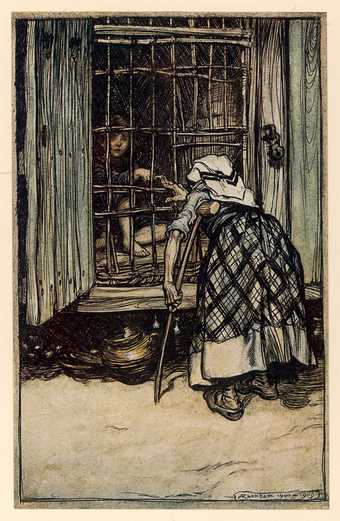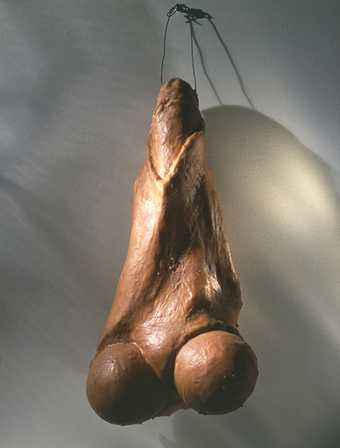Nancy Spero
I met Louise Bourgeois when her husband, the art historian Robert Goldwater, was still alive. He was an eminent African arts scholar, and at the time the first director of the Museum of Primitive Art. I thought there must have been a dialogue between his studies and her work. I felt her art was responding in some way, perhaps directly influenced by those totemic angular pieces that were in the museum. When Robert died, I think her work shifted in a different direction.
I really got into the early work. It has such energy about it. Sometimes it is wild, sometimes it feels more contained, sometimes it is even geometric. And there is a wonderful aura about it. The fearlessness that you sense in her art has certainly influenced me. She has always shown an extraordinary resilience and tenacity, which I have admired. That is important to remember because in the 1960s and early 1970s there was a certain reticence among younger female artists to acknowledge themselves as women. Louise completely ignored all that.
She has always been interested in younger artists’ work. I know that for a time she took an interest in the A.I.R. gallery – the women’s co-operative in New York that I co-founded in 1972. I remember there was a point when Louise Nevelson was very much in favour with galleries. Her work was all over the place. I noticed that Bourgeois was well aware of “the other Louise”, as some liked to call her, though they were both as much in the critical spotlight as each other. I think she once compared herself with Nevelson, which was intriguing, as Nevelson’s work was, despite some similarities in the 1940s and 1950s, so different – much more minimal than her organic forms.
Louise has always had a contradictory side to her. On one level she can be like a strict mother and quite controlling. One evening my late husband Leon (Golub) and I turned up three minutes late to dinner at her house and got a big telling off. However, on the other hand, you look at some of her work and it has this extraordinary freedom and imagination to it. Some of this contradiction comes across in her dress sense. She used to make these fabulous dresses – there is one with breasts attached to it. However, I remember seeing a photograph of her in a magazine, in which she is wearing a completely different style of dress altogether. It is one of those conventional ones – a seemingly demure outfit, you think, but in the picture she has one leg up on one of her sculptures, a big phallic white marble thing resembling a rising penis, and she is showing us a bit of leg; all very suggestive. The strong sense of sexuality and the sexual is so often apparent in her work. Above all, though, she is a force of nature, and that comes out in the art.
Helmut Lang
I was inspired by Louise Bourgeois’s work and always wanted to meet her. When the Vienna Kunsthalle approached me to select an exhibition, I thought it would be the moment to ask if she was interested in collaborating with me. She said yes. I met her for the first time on the steps of her townhouse in New York. She said: “Bonjour Helmut – welcome!” and kissed me. It took only this one moment to know that we probably had similar souls, and that this would be the beginning not only of a project but of a friendship. Since then I have valued every moment spent with her.
We went on to do a lot of collaborative work. In 2003 we used a reproduction of a silver choker she designed in 1948 in our spring/summer séance de travail [working session, Lang’s term for the presentation of a collection] in Paris. We then collaborated on t-shirt and scarf designs and used the soundtrack from recordings by Brigitte Cornand with Louise singing for two following shows. We exhibited her sculptures in the store in Paris on a rotating basis, and in the studios in New York we had The Cell, the installation shown at the Vienna Kunsthalle. We also did advertising featuring Louise. One advertisement was photographed by Bruce Webber, while another used an archive image by Robert Mapplethorpe. She made me one special sculpture, which took about two years, and insisted it be displayed for a while in the window of the then perfumery for the public to see.
Louise is French, so she knows how to be a woman and how to use lipstick without over-thinking it. Naturally, as all her senses are very refined, so is her idea of how she wants to look. When I moved to New York, I was happy to be an accomplice in providing things that she would like from my work. When I met her she didn’t leave her house any more, so she had comfortable clothes she would wear everyday, such as a long-sleeved t-shirt with six pocket eyes. She likes to keep the extravagant pieces for special occasions such as photo shoots or when she has company she cares about. Secretly, I always liked the idea that she would cut up one of these pieces and use it in her work. A few years ago she gave me an ethnic coat in pink and white striped silk which she used to wear the last few times she went out in New York. She thought it could be an inspiration for something and was sure that she wouldn’t wear it again.
I have a very strong emotional and unconditional bond with Louise, maybe because, as she once said herself, we are both runaways. Her impact on my life is both reassuring and animating, and of course knowing that one has found a similar soul is really what counts for me.


